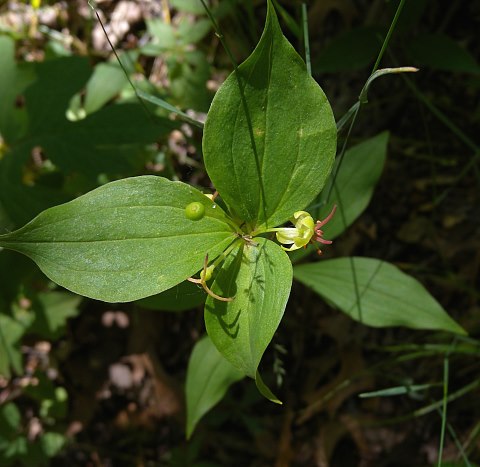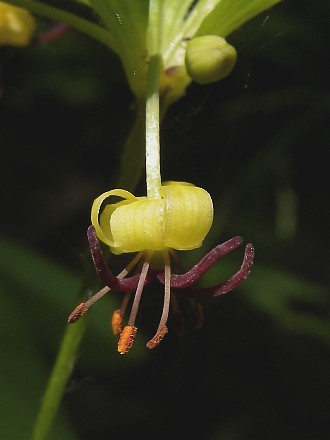
The inflorescence consists of a sessile umbel of 3-9 flowers on pedicels about 1" long. These flowers are held either a little above or below the leaves when they are in bloom. Individual flowers are about 2/3" (16 mm.) across, consisting of 6 yellowish green tepals, 6 stamens, a 3-celled ovary, and 3 reddish purple to brown stigmata. The tepals are lanceolate in shape and recurved. The stigmata are large in size and recurved, spanning the width of each flower. The pedicels are light green and glabrous. The blooming period occurs from late spring to early summer, lasting about 1 month. Afterwards, the pedicels become more erect, holding the developing berries above the upper whorl of leaves. At maturity, these berries are dark purple, globoid, and about 1/4" to 1/3" (6-8 mm.) across. Each berry contains several seeds. The root system consists of a thick rhizome with fibrous roots. Small colonies of plants can develop from the rhizomes.
Cultivation: The preference is dappled sunlight to medium shade, moist to mesic conditions, and soil containing loam or sandy loam with decaying organic matter.

Range & Habitat: The native Indian Cucumber-Root is located in two counties of NE Illinois, where it is rare and state-listed as 'endangered' (see Distribution Map). Illinois lies along the western range-limit of this species. Habitats consist of rich mesic woodlands, edges of swamps, forested bogs, and at the bases of wooded dunes. In mesic areas, this wildflower is typically located in beech-maple woodlands, while in more swampy areas it is found near Red Maple, Black Ash, and other deciduous trees that prefer moist areas.
Faunal Associations: Very little is known about floral-faunal relationships for this species. Sometimes, such small rodents as the White-Footed Mouse and Woodland Deer Mouse eat the seeds and berries (Hamilton, 1941).

Photographic Location: The base of a wooded sand dune near the edge of a swamp at the Indiana Dunes National Lakeshore in NW Indiana.
Comments: The common name refers to the flavor of the rhizome, which is said to resemble the flavor of cucumbers. Because of the oversized stigmata, the flowers of Indian Cucumber-Root have an odd appearance. Non-flowering plants with a single whorl of leaves superficially resemble an orchid, Isotria verticillata (Large Whorled Pogonia). However, this orchid has been found only in southern Illinois, where Indian Cucumber-Root does not occur. In areas where their ranges overlap outside of the state, these two species can be distinguished by the differing patterns of their secondary veins.